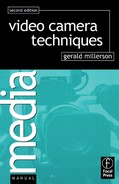Although the TV screen can only show us a flat image of the three-dimensional world, the audience gets a very convincing impression of depth and distance, thanks to the various visual clues they can see. They subconsciously interpret space by comparing relative sizes, converging lines (linear perspective), seeing how one plane overlaps another (masking) and how the relative positions of subjects change as the camera moves (parallactic movement).
A picture with a strong impression of depth, holds the interest, and is usually more convincing and attractive, than one which is flat and even-toned. If there are few visual clues to depth in a picture, it can be hard to judge scale, space and distances (e.g. as in open desert landscapes).
There are several ways in which you can give a picture a greater feeling of depth and realism:
• Try to avoid having the subject isolated against a plain background, particularly where the lighting is flat and diffused, or shining from behind the camera (dead frontal).
• Where there are familiar-sized subjects in the shot (people, furniture) the viewer will get a better idea of distance and scale.
• When the camera shoots through clearly-defined foreground planes, such as foliage or a window-frame, the illusion of depth is considerably enhanced.
Whenever you select or arrange foreground subjects to improve scenic depth, introduce them as naturally as possible. Effective enough when they are appropriate (e.g. the viewpoint of a person in hiding), they can become too obtrusive if overdone.
Resist the temptation to use foreground pieces habitually, in shot after shot – ‘just to complete the picture’. And steer clear of a ‘peek-a-boo’ camera style, in which you continually shoot the subject through grass, bead curtains, holes in a fence …
Another favorite trick that can be overused, is to begin a shot with a clearly focused image of an unimportant foreground object (such as a wayside flower), then pull focus dramatically to blur it completely, bringing the real subject which is in the distance into sharp focus (e.g. a car speeding along on the highway).
The illusion of depth
Foregrounds can help to create a greater impression of depth, distance and scale, particularly for isolated, remote subjects.
Foreground planes
Where the camera shoots the action beyond a foreground plane such as a window, screen, foliage, this can form a natural border to the picture.

